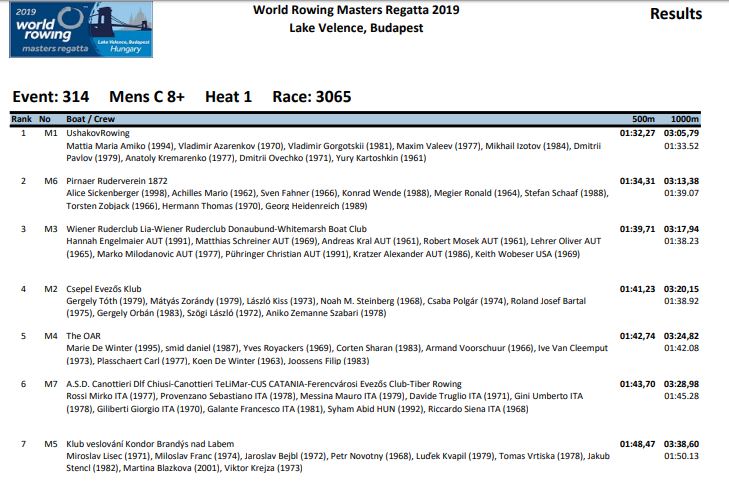Our training on the water has become more intensive. Unfortunately we have very different current conditions on the river depending on the season. One week ago we had an interesting topic in our Master C eight:
If we row our units against the current, we find much higher times than downstream. This is clear to everyone. Current. Makes sense. Frustrating however that one cannot compare these times over 1000 m or 2000 m.
Fortunately, it’s not so
Patrick, stroke and captain of our eight, has mathematically investigated the calculation of training times to find a comparable reference time. At every training session and in comparison with international results.
 WRMR Velence, result chart
WRMR Velence, result chart
Mathematical calculation of training times
First of all it is important to calculate the water resistance or the current’s velocity. If we have this data, we can determine the speed of the boat and the 1000 m times in standing water. Here’s the data:
Masters C Eight: 1000 Meter
- Upstream: 4.12 min = ca. 14.4 km/h
- Downstream: 2.50 min = ca. 21.2 km/h
Consequently, the resistance and flow velocity (Vr) of the current:
14.4 + Vr = 21.2 – Vr /// 2 x Vr = 21.2 – 14.4 /// Vr = 3.4 km/h
So the calculation of training times or rowing times as an average of our oar eight was: 14.4 + 3.4 = 21.2 – 3.4 = 17.8 km/h In standing water, 17.8 km/h would correspond to a time of 3:22 km/h. Patrick’s simple average between 2:50 and 4:10 would have been 3:30.
This is a simple mathematical model. Training level, season, wind, waves and other influences are not considered. Therefore a rather optimistic model.
Master C in international comparison
As a result, our eight rowed an average time of 3:22 km/h in 2 training sessions. Comparing this with the average winning times of the World Masters Regatta 2019 in Hungary, the times of the Masters C there were 3:10 km/h. So our eight still has some room for improvement.
If you are looking for general information about regatta times: articles about prognostic forecasts





